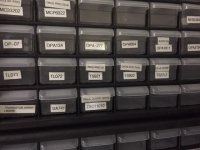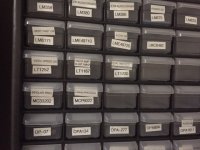I use the LF412 a lot since I bought many cheap and they tested well in one of Cordell's publications.
I recently bought some TL074's since a quad is fantastic for perf board construction.
I see the LM324 getting slammed. Can someone recommend a good cheap bipolar input quad op amp?
I recently bought some TL074's since a quad is fantastic for perf board construction.
I see the LM324 getting slammed. Can someone recommend a good cheap bipolar input quad op amp?
LF412 looks good.
It is a JFET opamp with low offset.
Now LME49710 is not a JFET input opamp.
But the input current is as low as typical 7nA,
so thats not a problem.
It is a JFET opamp with low offset.
Now LME49710 is not a JFET input opamp.
But the input current is as low as typical 7nA,
so thats not a problem.
I picked up a few njm2068, njm2114, and some ne5532 the last time I ordered from digikey.
No tears if one gets woofed out...
No tears if one gets woofed out...
I have TL071/072, and NE5532/5534 in the parts box. That is enough for 99% of my projects.4558's, TL071/72, NE5532 and 741's will let you experiment with most projects whether they be audio or not.
I've used 741's when I was a child a long time ago, but not since then. They were wonderful for their time, but that time has long since gone.
For audio, I have never heard the slightest improvement over the 5532 / 5534 from any of the technically better op-amps, so I don't bother with them. Sometimes "new and improved" is merely new, and no worthwhile improvement is actually possible.
The only other type of op-amp I've occasionally found a need for was something with a MOSFET output stage that can swing all the way to its supply rails, like the old TLC272. There are a few oddball applications where you need that ability.
-Gnobuddy
oh pissoff, sendsome myway
hey LineUp,
Are you using the single opamp extra circ?

With single opamps:
132/4
604 @24V
5534
AD797
As Andrew T said
"...
The dual only has access to the three standard in/out pins, whereas the single has all 6pins available.
The internal unity gain compensation of the dual makes it's electrical performance significantly different.
...."
hey LineUp,
Are you using the single opamp extra circ?

With single opamps:
132/4
604 @24V
5534
AD797
As Andrew T said
"...
The dual only has access to the three standard in/out pins, whereas the single has all 6pins available.
The internal unity gain compensation of the dual makes it's electrical performance significantly different.
...."
Last edited:
I've used 741's when I was a child a long time ago, but not since then. They were wonderful for their time, but that time has long since gone.
For audio, I have never heard the slightest improvement over the 5532 / 5534
Paraphrasing 1:Corinthians 13:11 ,,, "When I was a child, I engineered like a child..."
I think that TI has put some extra goodness in their range of NE5534. Just sounds great.
I still like the LM4562 for a dual.
OPA2604 is another.
Unlike Mark, I keep my legged opamps on static free foam and sort by manufacturer -- I have not married Analog and Linear Tech yet, they remain celibate and in their own prophylactic enclosures.
LF412 and NE5532 suffice for most of the signal path portion of my audio work. But I go through more LM358 and LM324 than I do the other two - for all the support circuitry which is common to equipment which doesn't use op amps in the signal path. Also lots of LM311 and 339.
Unlike Mark, I keep my legged opamps on static free foam
Dude -- black ESD foam INSIDE the drawer. It'll hold a stack of 5-6 layers including ICs.
I just checked your circuit. Your power supply is +/-10V. Even with +/-15V, OPA2604 performance is unacceptable. It needs higher rail to perform (that's why it is often lost in an op-amp rolling).
ADD:
And have you checked OP275? It's another underdog op-amp because it doesn't perform well in a conventional circuit.
Ah, I must not have carefully checked the datasheet! Thanks 🙂 I haven't looked at the OP275.
Tony.
What would you say about LME49710?
Compared to OPA134?
Very different op-amp: less voltage noise, but lots of current noise.
Yes, I can use the 'extra pins'.oh pissoff, sendsome myway
hey LineUp,
Are you using the single opamp extra circ?
View attachment 681742
With single opamps:
132/4
604 @24V
5534
AD797
As Andrew T said
"...
The dual only has access to the three standard in/out pins, whereas the single has all 6pins available.
The internal unity gain compensation of the dual makes it's electrical performance significantly different.
...."
For example NE5534and unity gain, there is a cap 22pF to add.
Also can use 2 pins to adjust offset.
There are 2 reasons why I fancy single op amps.
1. The easier design of pcb. With dual op amp the card get 'crowded'. While I can have more space with two single op amps.
2. The maximal power. Two in a dual gives only half the power for each. The single op will run cooler.
There is at least one thing that speaks for OP275.I just checked your circuit. Your power supply is +/-10V. Even with +/-15V, OPA2604 performance is unacceptable. It needs higher rail to perform (that's why it is often lost in an op-amp rolling).
ADD:
And have you checked OP275? It's another underdog op-amp because it doesn't perform well in a conventional circuit.
Power supply can be max +/-22 Volt.
The same goes for NE5534.
Many op amps are restricted to +/-18V.
For example LME49710 is recommend to run at +/-17 Volt.
OPA604 can take +/-25 Volt. Absolute max.
It is unusual.
Last edited:
For audio, I have never heard the slightest improvement over the 5532 / 5534 from any of the technically better op-amps, so I don't bother with them. Sometimes "new and improved" is merely new, and no worthwhile improvement is actually possible.
-Gnobuddy
Ain't that the truth. For low gain, low noise circuits, the 5532 does it all except for low offset. It behaves as a voltage follower with no fussing. It's low noise. It does not mess with the sound.
I like to DC cascade circuits as much as possible. OPA2134 is limited as a follower but works fine as an inverter. I cascade inverting circuits; 2134 goes in front, then 5532. In practice this works great and yields acceptable offset (less than 20 mV) without optimizing DC parameters.
yes, the LM358 is not an audio opamp. Thank you for pointing this out! 🙂DON'T USE LM358 FOR ANY SIGNAL WHOSE BANDWIDTH EXCEEDS 1 HERTZ.
If you post the internal, transistor level schematic of the LM358, I will help you draw a red circle around the portion of the design that is responsible for its (intentional!!) severe crossover distortion.
I like the OPA2134 as a "jellybean" type of dual opamp. It's hard to make it cause issues, and they have very good consistency.
- Status
- Not open for further replies.
- Home
- Design & Build
- Parts
- Op Amps good to have at home in your box

